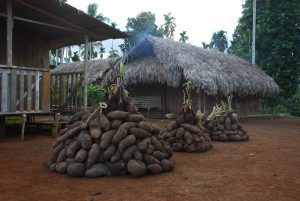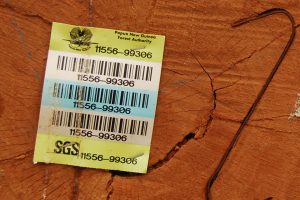Properties of Units and Standards can be broken down to three constituent parts (sub-projects) that reveal its scope:
1) Local quantification systems
What kinds of base units and number bases are used in the various vernacular, informal, and  parallel scales, measures, or numeracy systems in Oceania? The first subproject focuses on the material affordances of concrete units of agricultural produce and exchange media, but also on local number vocabularies, methods of measuring and indicating size, weight, or volume, and other commonplace instances where numbers are performed into existence. This sub-project seeks to provide a wide-ranging view into the multi-scalarity of ordinary life using easily graspable examples. By thus illustrating the project’s concern with the affordances of units, this subproject particularly seeks to call attention to the materiality of different yardsticks, and how it has a crucial effect on the establishment of numeric value. Oceanic quantification systems serve to illustrate the relation of units to numbers: they provide the material with which the affordances of units can be demonstrated—exemplars that can be used to illustrate a complicated subject matter both to anthropological and wider audiences.
parallel scales, measures, or numeracy systems in Oceania? The first subproject focuses on the material affordances of concrete units of agricultural produce and exchange media, but also on local number vocabularies, methods of measuring and indicating size, weight, or volume, and other commonplace instances where numbers are performed into existence. This sub-project seeks to provide a wide-ranging view into the multi-scalarity of ordinary life using easily graspable examples. By thus illustrating the project’s concern with the affordances of units, this subproject particularly seeks to call attention to the materiality of different yardsticks, and how it has a crucial effect on the establishment of numeric value. Oceanic quantification systems serve to illustrate the relation of units to numbers: they provide the material with which the affordances of units can be demonstrated—exemplars that can be used to illustrate a complicated subject matter both to anthropological and wider audiences.
2) The establishment of regional quantification regimes
What are the diverse effects that large-scale modes of appraisal or evaluation can have on the  social constellations and physical environments upon which they are brought to bear? The second sub-project looks into the establishment of formal, authoritative quantification regimes in Oceania. In the PI’s case, for example, this means piecing together a history of Fijian taxation, from precolonial tributes to the work of the current Customs and Revenue Authority. Various modes of tax appraisal, tested and implemented over two centuries in Fiji, have had effects that are still observable in the landscape, on livelihoods, on modes of accounting, and beyond. In all three locations, the theoretical insight sought through the second sub-project is consequentiality: the diverse runaway effects which large-scale modes of appraisal or evaluation can have on the social constellations and physical environments upon which they are brought to bear. This sub-project, in other words, addresses the second assumption underlying the Units project: that the attributes of units do not just affect the numbers created in reference to them, but that the act of signification inherent in measuring also makes its mark upon the world—is an act of world-making.
social constellations and physical environments upon which they are brought to bear? The second sub-project looks into the establishment of formal, authoritative quantification regimes in Oceania. In the PI’s case, for example, this means piecing together a history of Fijian taxation, from precolonial tributes to the work of the current Customs and Revenue Authority. Various modes of tax appraisal, tested and implemented over two centuries in Fiji, have had effects that are still observable in the landscape, on livelihoods, on modes of accounting, and beyond. In all three locations, the theoretical insight sought through the second sub-project is consequentiality: the diverse runaway effects which large-scale modes of appraisal or evaluation can have on the social constellations and physical environments upon which they are brought to bear. This sub-project, in other words, addresses the second assumption underlying the Units project: that the attributes of units do not just affect the numbers created in reference to them, but that the act of signification inherent in measuring also makes its mark upon the world—is an act of world-making.
3) Composite indicators and data
How far can a conceptual approach grounded on material properties be extended? Can it be applied to the global indicators that connect the South Pacific with North Europe?
Here, the project further sheds its materialist orientation to examine how phenomena like happiness, risk, creditability, or corporate reputation are measured, not just in Oceania but in contemporary Europe, too. This part also shifts the investigators’ emphasis further away from on-site fieldwork, into policy papers, conventions, and other public documents that outline the phenomena, statistics and other relevant data that make up the “units” upon which composite indicators, too, are established. This sub-project not only moves from material affordances to the way abstract phenomena are made conceptually available for measuring, but also seeks to bridge the South Pacific with (North) Europe. This move is made for two reasons: to test the applicability of the unit-centred approach for more complex phenomena, but also to put the project’s findings more firmly in dialogue with other, contemporary research on quantification.
